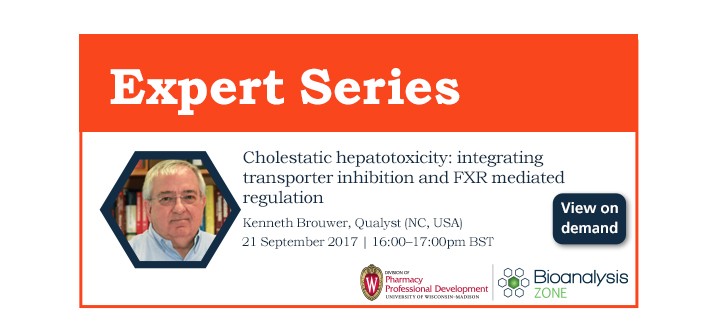Expert Series: Cholestatic hepatotoxicity: integrating transporter inhibition and FXR mediated regulation

Speaker: Dr. Kenneth Brouwer
Dr. Brouwer has over 25 years’ experience in preclinical drug development and is a co-founder of Qualyst, a provider of hepatic drug transporter products and research services. Prior to founding Qualyst, Dr. Brouwer served as Executive Director, Drug Metabolism and Pharmacokinetics at PPD Discovery, where he directed research in metabolism, pharmacokinetics, toxicology, and absorption technologies.
Previously he served as Director, Preclinical Development, Drug Metabolism and Pharmacokinetics at GlaxoSmithKline and was responsible for the drug metabolism and pharmacokinetics strategy leading to candidate selection, review of candidate project plans prior to candidate selection, and developing and implementing process to ensure a smooth transition from candidate selection to full development.
Dr. Brouwer has over 25 publications in peer reviewed journals, holds two patents, serves on the Editorial Advisory Board for the Journal of Pharmaceutical Sciences, and is an adjunct faculty member in the Division of Drug Delivery and Disposition at the School of Pharmacy, University of North Carolina.
In this webinar Kenneth Brouwer explains how bile acid homeostasis is essential for liver health and disruption leads to hepatocellular damage. The ability to evaluate a new drug candidate’s potential to cause cholestatic drug induced liver injury (DILI) is an important component of drug discovery research. Currently, most cholestatic DILI screening efforts in early discovery research focus on a drug candidate’s potential to inhibit canalicular bile salt export pump which would lead to increased intracellular concentrations of bile acids and hepatotoxicity. However, the intracellular concentrations are tightly regulated through multiple mechanisms. Increased intracellular concentrations of bile acids activate FXR, and result in decreased synthesis of bile acids, increased expression of BSEP (canalicular efflux of bile acids) and increased expression of OSTs (basolateral efflux transporter). This presentation will illustrate the initiating events, the hepatocyte’s response and the time frame of the response in the regulation of bile acids.
For more webinars from our expert series click here
